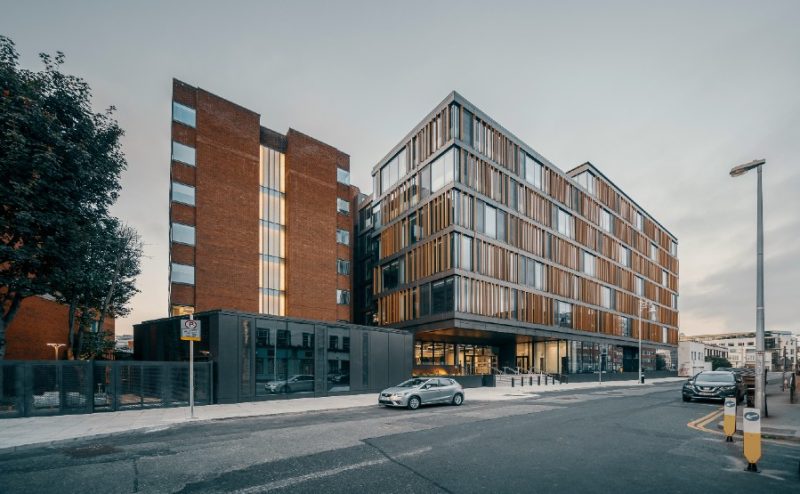
1 Cumberland Place, a high-profile office building in central Dublin owned by Hibernia Real Estate Group, is leading the way on sustainability by demonstrating how retrofitted properties can deliver industry-leading reductions in energy demand while retaining much of their original structure and skin, thus avoiding the significant additional embodied carbon associated with newly constructed buildings.
Hibernia has invested up to €30m in upgrading 1 Cumberland Place, a process that began in 2015 and has involved detailed monitoring of how the building works and the changes necessary to reach net zero carbon.
To document the decarbonisation journey to date for 1 Cumberland Place, and the subsequent improvement in its energy performance, Hibernia recently commissioned a case study report by RKD Architects, which has been published today. The report has concluded that the office building presents a “positive exemplar for how Ireland’s built environment can carve out a pathway to net zero”.
The report found that:
· 1 Cumberland Place outperforms existing Irish office stock on several metrics
· The building’s refurbishment improved its BER from E2 to B2, representing a 63% reduction in rated primary energy demand and placing it within the top 5% of Irish offices
· With a further 39% improvement in efficiency realised due to the installation of innovative energy reduction and heat recycling technology over the last 2 years, its measured performance is now even better than suggested by its BER
· Such energy performance would be impressive for any office building, but especially as it has been achieved while retaining the majority of 1 Cumberland Place’s structure and much of its skin, resulting in an embodied carbon footprint estimated to be 66% lower than that of a new office building
The United Nation’s latest global status report estimated that the operation and construction of the built environment accounted for 37% of process and energy-related emissions in 2022. It is against this background that Hibernia is working to decarbonise its existing office building stock by measuring how its buildings operate and then implementing measures to improve their performance.
1 Cumberland Place is a seven storey, 130,000 sq. ft. office building, originally constructed in the early 1970s, located on the junction of Bass Place and Fenian Street in Dublin’s city centre. Formerly known as Cumberland House, it was purchased by Hibernia in 2015 and €29 million was invested in an extensive refurbishment. The building’s key sustainability merit is the that it achieved its operational performance status as a refurbishment. As part of this work, Hibernia sought to preserve as much of the structure and the skin of the building as possible, therefore limiting its ability to choose modern, off-the-shelf decarbonisation technologies generally used on new builds. Heat recovery ventilation, LED lighting and power factor correction were all applied, leading to the building achieving a B2 BER and LEED (Leadership in Energy and Environmental Design) Platinum certification in May 2017.
More recently Hibernia wanted to take the building’s performance a step further as part of its decarbonisation journey. Starting in 2021, additional improvements were made to the building’s operations. A new energy data management system was supplied by Wicklow-based CoolPlanet, making it easier to track and understand 1 Cumberland Place’s decarbonisation metrics including energy, water, waste, and Scope 1, 2 & 3 emission levels. This created the opportunity for further action and data-led engagement with occupiers. Secondly Hibernia invested in new demand control ventilation technology supplied by Dublin-based Symphony Energy. Symphony’s system uses a combination of sensors and bespoke software to optimise heating and cooling based on real-time demand. It also allows for the recycling of waste heat into usable heat while generating free cooling for the building.
RKD’s report shows that, as a result of these additional measures, primary energy demand in 1 Cumberland Place has reduced from 337 kWh/m2 in 2018 to 208 kWh/m2 in 2022, a drop of 38%, and the building’s energy use intensity has reduced from 205 kWh/m2 in 2018 to 125 kWh/m2 in 2022, a drop of 39%.
Neil Menzies, Director of Sustainability at Hibernia said: “As an industry, we need to look beyond building energy ratings and certifications to focus on in-use building performance. It is vital that we continually monitor, manage and improve the performance of our existing buildings, working out how they operate and understanding how they are used. The next step is being prepared to invest in improvements over time – what we refer to as our journey to net zero. Having achieved LEED Platinum at 1 Cumberland Place in 2018, we wanted to see if further improvements were possible. By partnering with CoolPlanet and Symphony, we have been able to reach greater levels of energy efficiency, and this will be crucial to our ambitions to become a net-zero carbon and climate resilient business by 2030.”
Tom Ascough, Managing Director of Symphony Energy, said: “1 Cumberland Place was already a highly efficient LEED Platinum-rated building, so it was a brave approach by Hibernia to try to drive energy efficiency even further. Our innovative solution has taken its performance to a next generation standard. While the energy efficiency achieved at 1 Cumberland Place is a testament to the advanced technology in use, the even better news for the planet is that this achievement can be replicated in a multitude of commercial buildings.”
Dr Richard O’Hegarty, Research Lead at RKD Research said: “1 Cumberland Place outperforms the existing Irish office stock on several metrics and presents a positive exemple for how Ireland’s built environment can carve out a pathway to net zero. This is a positive story that can encourage similar action nationally and elsewhere. If it is used as an exemplar, it is important to note that achieving such results requires a hands-on approach to building monitoring, management, and improvement.”